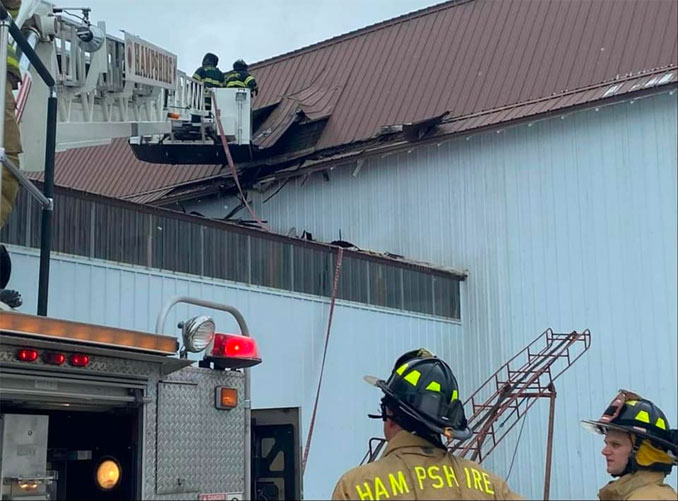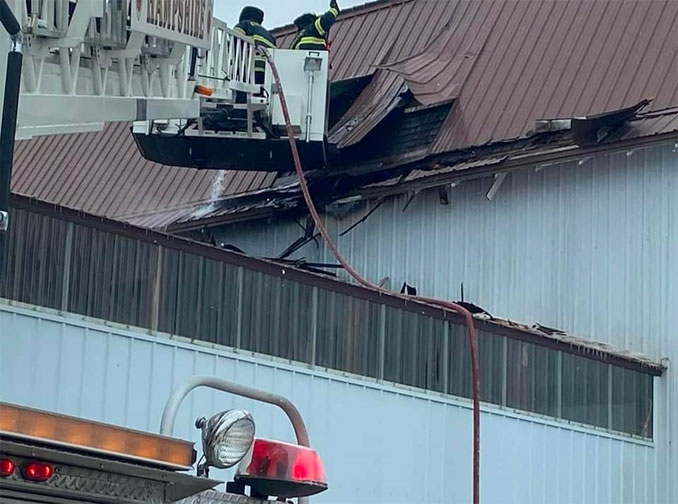
Police, firefighters and paramedics from Hampshire responded about 10:45 a.m. Friday, January 21, 2022 to a report of an explosion in “Building P” of the W.R. Meadows Inc. manufacturing complex, 300 Industrial Drive in Hampshire. The first Hampshire fire units arrived within three minutes and discovered first that the building sustained significant damage. The building’s fire suppression system was activated automatically and knocked down the fire before firefighters arrived. There was no active fire.
There were two employees in the portion of the building where the explosion occurred. One patient was pronounced deceased at the scene, and another patient was extricated and transported to Sherman Hospital in Elgin. The patient was then transferred by medical transport helicopter to a hospital in Rockford.
The remainder of the building was searched and no other victims were found inside, and no other injuries were reported, according to Hampshire Fire Chief Trevor Herrmann. An initial investigation determined that an accidental explosion occurred that was caused by an electrical event in an explosive vapor atmosphere.
A south wall in the building’s southeast corner was blown out. The steel wall and some frame materials were visible as debris on the ground outside the building, and two white upright tanks were visible inside the building.
Mutual aid fire departments responded from Burlington, Pingree Grove, Huntley, Fox River, Marengo, Genoa, Sycamore and Elburn.
Fire investigators were joined by the Kane County Task Force, The Illinois State Fire Marshal, and the Occupational Safety and Health Administration (OSHA).
Early reports indicated two people were seriously injured. Both of the injured people were employees.
The Kane County Sheriff’s Mobile Command Center and the Kane County Coroner also responded to the scene. Hampshire police were joined by the Kane County Sheriff’s Office, the Hampshire Building Department (SafeBuilt Inc.) and the Kane County Office of Emergency Management.

According to the company’s website, W.R. Meadows manufactures flashing membranes, air barriers, waterproofing, vapor barriers, and other concrete-related products for the construction industry. The company was founded in Elgin in 1926, and now has a headquarters and plant in Hampshire, Illinois, and locations in Arizona; California; Georgia; Pennsylvania; Texas; Alberta, Canada; and Ontario, Canada.
The company has comprehensive Safety Data Sheet (SDS) information on their official website that includes several hazardous materials and flammable materials located on site that require isolation from ignition sources. SDS information follows standards from OSHA (the Occupational Safety and Health Administration).
Flammable chemical components onsite in manufacturing include acetone, benzene, light aromatic naphtha solvent, mineral spirits (turpentine), and xylene.
There was no known hazmat beyond the W.R. Meadows property. According to NWS data at De Kalb Taylor Municipal Airport, wind was from the South at 13 MPH and air temperature was 20°F at 11:35 a.m. Wind was from the South at 12 MPH and air temperature was 21°F at 11:55 a.m.
The OSHA Hazard Communication Standard (HCS) (29 CFR 1910.1200(g)), revised in 2012, requires that the chemical manufacturer, distributor, or importer provide Safety Data Sheets or SDSs (formerly MSDSs or Material Safety Data Sheets) for each hazardous chemical to downstream users to communicate information on these hazards. The information contained in the SDS is largely the same as the MSDS, except now the SDSs are required to be presented in a consistent user-friendly, 16-section format. This brief provides guidance to help workers who handle hazardous chemicals to become familiar with the format, and understand the contents of the SDSs.
The SDS includes information such as …
the properties of each chemical;
the physical, health, and environmental health hazards;
protective measures;
and safety precautions for handling, storing, and transporting the chemical.
The information contained in the SDS must be in English (although it may be in other languages as well). In addition, OSHA requires that SDS preparers provide specific minimum information as detailed in Appendix D of 29 CFR 1910.1200. The SDS preparers may also include additional information in various section(s).
Sections 1 through 8 contain general information about the chemical, identification, hazards, composition, safe handling practices, and emergency control measures (e.g., fire fighting). This information should be helpful to those that need to get the information quickly.
Sections 9 through 11 and 16 contain other technical and scientific information, such as physical and chemical properties, stability and reactivity information, toxicological information, exposure control information, and other information including the date of preparation or last revision. The SDS must also state that no applicable information was found when the preparer does not find relevant information for any required element.
The SDS must also contain Sections 12 through 15, to be consistent with the UN Globally Harmonized System of Classification and Labeling of Chemicals (GHS), but OSHA will not enforce the content of these sections because they concern matters handled by other agencies.
Get updates from The Cardinal ALL NEWS FEEDS on Facebook. Just ‘LIKE’ the ‘Arlington Cardinal Page (become a fan of our page). The updates cover all posts and sub-category posts from The Cardinal — Arlingtoncardinal.com. You can also limit feeds to specific categories. See all of The Cardinal Facebook fan pages at Arlingtoncardinal.com/about/facebook …
Help fund The Cardinal Arlingtoncardinal.com/sponsor
See also …
OSHA BRIEF | Hazard Communication Standard: Safety Data Sheets [PDF]
